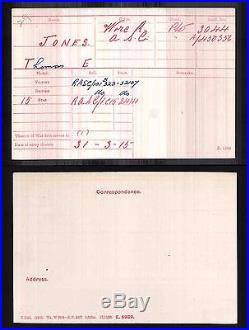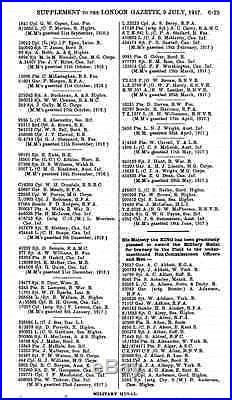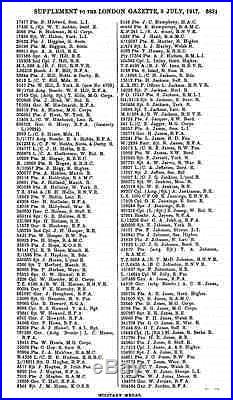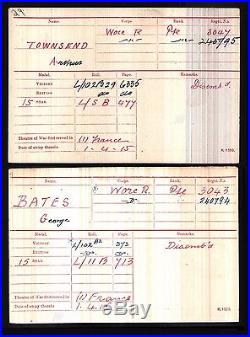First World War GvR Military Medal group of three to Worcestershire Regiment Territorial. GvR Military Medal (swivel suspender): 240793 PTE T. British War and Victory Medals: 3044 PTE. Jones’ MM was gazetted on 9/7/1917, further research shows this was one of 5 Military Medals awarded for the Battalion’s ill-fated attack on Gillemont Farm on 24th April 1917 (see details from regimental history below). While Jones’ medal index card doesn’t confirm his number change from 3044 to 240793 prior to being transferred to the ASC, two further MICs to 3043 Pte George Bates 1/8th Worcesters and 3047 Pte Arthur Townsend 1/8th Worcesters are included in the sale which confirm regimental number changes to 240794 and 240795 respectively. Thomas Jones was from Malvern in Worcestershire. The 1/8th Worcestershire Regiment served with 48th (South Midland) and 25th Divisions in France, Flanders and Italy taking part in engagements at Ploegsteert Wood, Hebuterne, Ovillers, Le Sars, Butte de Warlencourt, Templeux-le-Guerard and Gillemont Farm during the German retreat to the Hindenburg Line, Passchendaele, Vimy, and actions on the Piave in Italy, before returning to France for the last hundred days where they captured Beaurevoir, Pommereuil and Landrecies. A fine record for a Territorial unit! Silver medals toned attractively black. All three medals in EF condition. A great, researchable item to a Wiltshire POW. The regimental history records a detailed account of the 24th April 1917. Preparations for the Attack. On April 20th began the last phase of operations in front of the Hindenburg Line. From the ridge captured by the 48th Division on April 13th a spur runs down north-eastward towards the canal. It seemed likely that that spur if captured would give observation over the main Hindenburg Line, which there ran back across the Canal and thence southwards through the village of Bony. On the crest of that spur stood Gillemont Farm. Immediately to the north, a similar underfeature culminated in a small height known as The Knoll. Plans for the capture of Gillemont Farm and The Knoll were made by the 48th Division, and on April 19th an attack was made by the 145th Brigade: but the enemy defences were strong and the attack failed. That evening the 144th Brigade took over the line, with orders to continue the operation. Marching forward from their camp near Roisel the 1/8th Worcestershire Regiment relived the 1/4th OBLI on the ridge before Gillemont Farm, and spent the next 48 hours in reconnaissance and patrolling across the ground over which their predecessors had attacked. Orders were received that the Battalion would attack the Farm on April 24th. Further north the 1/6th Gloucestershire would attack The Knoll. To give the attacking Battalion full time for preparation, the 1/7th Worcestershire were brought forward on the 21st from their billets at Hamel; they took over the line, and the 1/8th Worcestershire moved back to camp near Villers Faucon. The 1/8th Worcestershire attack Gillemont Farm. After forty-eight hours rest, the 1/8th Worcestershire moved forward on the evening of April 23rd. A,”C’ and’D’ Companies, which were to make the attack, halted and rested in the quarries of Templeux-le-Guerard, while’B’ Company, which was intended for the Battalion reserve, went forward to take over the line of the 1/7th Worcestershire. The latter Battalion moved back to camp at St Emilie, leaving two Companies (‘A’ and’B’) in reserve positions (A on reverse slope of the ridge, and B near Ronssoy) to assist the attack. In the small hours of the morning of the 24th that attacking companies moved forward to the line and deployed, A Coy on the right, then C and D. The two latter companies, led respectively by Captains F W Hemming and A Plaistowe, were to carry the spur, wile A Coy was to seize a small copse across the valley to the right. At 0345, under a heavy fire the attack commenced. Dashing forward with the bayonet, C and D Coys stormed the Farm; but on the right, the attacking two platoons of A Coy, checked by thick wire and without artillery support could not take the copse. Daylight came on and after their leader, Lt L R Bomford, and many of his men had been hit, the survivors of A Coy fell back to their trenches. Away to the left the 1/6th Gloucestershire had failed similarly to secure The Knoll, but in the centre C and D Companies had cleared the spur and were endeavouring to entrench Gillemont Farm. As the light grew the captured position on the narrow spur was bombarded from the north, east and south by the enemy’s guns and was raked by machine-guns both from The Knoll and from the high ground to the south near Malakoff Farm. Under the hail C and D Coys held their ground; but officers and men fell fast. Fortunately there was no lack of brave leaders to inspire the defence. 2/Lt R M Pittard took command of his company after the other officers had fallen and directed both defence and the work of entrenchment with coolness and ability. Sgt W Pitt though twice wounded remained in command of his platoon. L/Cpl A Woodward took charge of a platoon after all leaders had fallen and bravely controlled the defence. Further back the Battalion Signalling Officer, 2/Lt G H Jones, showed courage and resource in maintaining telephone communication from Battalion HQ to the captured farm. Many times he passed through the shell-fire and the bullets of the German machine-guns, and the line though often broken was always restored. At about 0830 the enemy began a counter attack in force. Covered by an intense bombardment, strong columns of German infantry pressed up the valleys on either side and closed in on the Farm. Realising that further defence of the spur was hopeless, Captain Plaistowe gave the order to retire. Under a storm of fire the survivors of the two companies fought their way back along the spur to their original position. The losses in the two companies had been very heavy – nearly 160 in all, including nine officers (among them Captain F W Hemming and Captain A Plaistowe OCs C and D Coys). 1/7th Worcestershire Renew the Attack. After dark the 1/7th Worcestershire came up and took over the line, with orders to renew the attack that same night (A Coy had already been involved as reserve and providing carrying parties). The 1/8th Worcestershire moved back to the Templeux quarries. Dispositions were made for the renewed attack. Three battalions were to be employed. The 1/7th Worcestershire would attack Gillemont Farm. On their left the 1/4th Gloucestershire were to attack The Knoll and on their right the 1/4th Royal Berkshire were to take the copse across the valley. At 2300 the British guns redoubled their fire and the attack began. C and D Coys of the 1/7th Worcestershire went forward along the spur, with B Coy close behind in second line. A confused struggle ensued in the darkness with bomb and bayonet, but eventually the Worcestershire lads forced the enemy out of the Farm and down the slopes. Then they hastily entrenched. Dawn (April 25th) as before, brought a storm of fire from all directions. Once again the attacks on either flank had failed, and the narrow spur gave the enemy a target impossible to miss. At 0600 a strong counter attack was made and with difficulty it was beaten off. The sharp slopes of the spur enable the enemy to concentrate in dead ground close below the captured position. In order to provide a longer field of fire, the foremost of the Worcestershire platoons were drawn back from the end of the spur to the trenches close to the Farm. There a firm position was consolidated and neither fire nor counter-attacks succeeded in ousting the 1/7th Worcestershire throughout the day. At nightfall the 1/4th Royal Berkshire took over the captured position, and the Worcestershire made their way back to camp near Villers Faucon. The losses of the Battalion were about 150, including two officers killed and four wounded. Among the latter was Captain Prescott, commanding B Coy, who although wounded early in the attack, stubbornly continued in command until the Battalion was relived. On April 28th the 1/7th Worcestershire moved back to billets at Hamel, whence the 1/8th Worcestershire came up to take over their camp. The capture of Gillemont Farm was the last heavy fighting seen by the Regiment in those operations before the Hindenburg Line. For a few more days the 48th Division remained in the area, and the 1/8th Worcestershire took over Gillemont Farm position on the 29th April. All firing had died down by that time, and the line was very quiet. The centre of gravity of the campaign had shifted northwards. On May 1st both Territorial Battalions moved back with the rest of the Division for training. Stacke, Capt H FitzM The Worcestershire Regiment in the Great War 1914 – 1918 Kidderminster 1921. The item “WW1 Military Medal group of 3 Worcestershire Regiment Territorial 1917 JONES” is in sale since Monday, December 05, 2016. This item is in the category “Collectables\Militaria\World War I (1914-1918)\Medals/ Ribbons”. The seller is “wignorian” and is located in Hereford. This item can be shipped worldwide.
- Type: Medals & Ribbons
- Era: 1914-1945
- Conflict: World War I (1914-1918)
- Service: Army
- Country/ Organization: Great Britain
- Issued/ Not-Issued: Issued











